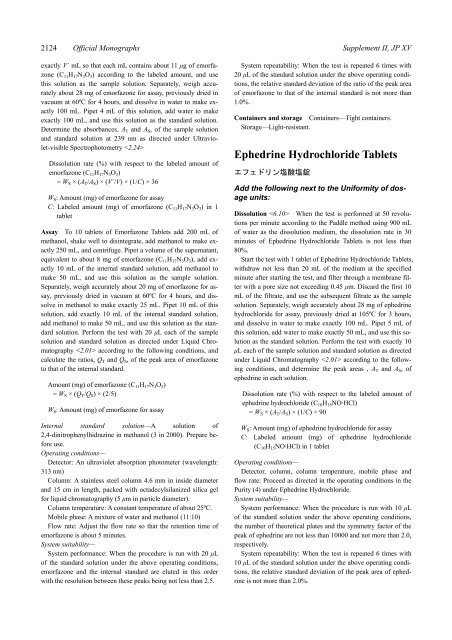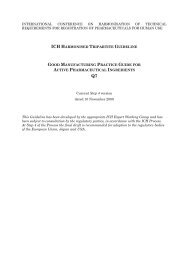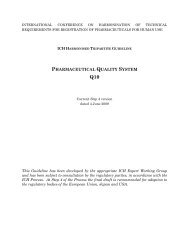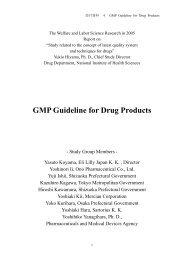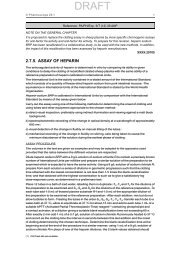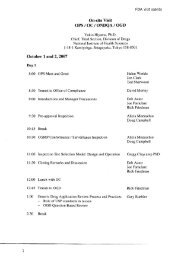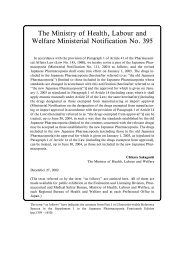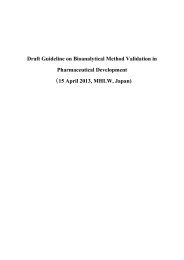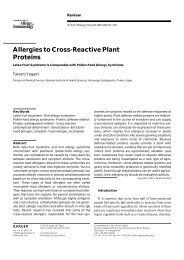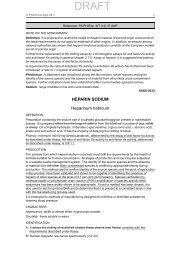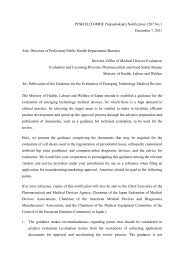supplement ii to the japanese pharmacopoeia fifteenth edition - NIHS
supplement ii to the japanese pharmacopoeia fifteenth edition - NIHS
supplement ii to the japanese pharmacopoeia fifteenth edition - NIHS
You also want an ePaper? Increase the reach of your titles
YUMPU automatically turns print PDFs into web optimized ePapers that Google loves.
2124 Official Monographs Supplement II, JP XVexactly V´ mL so that each mL contains about 11 µg of emorfazone(C 11 H 17 N 3 O 3 ) according <strong>to</strong> <strong>the</strong> labeled amount, and usethis solution as <strong>the</strong> sample solution. Separately, weigh accuratelyabout 28 mg of emorfazone for assay, previously dried invacuum at 60ºC for 4 hours, and dissolve in water <strong>to</strong> make exactly100 mL. Pipet 4 mL of this solution, add water <strong>to</strong> makeexactly 100 mL, and use this solution as <strong>the</strong> standard solution.Determine <strong>the</strong> absorbances, A T and A S , of <strong>the</strong> sample solutionand standard solution at 239 nm as directed under Ultraviolet-visibleSpectropho<strong>to</strong>metry Dissolution rate (%) with respect <strong>to</strong> <strong>the</strong> labeled amount ofemorfazone (C 11 H 17 N 3 O 3 )= W S × (A T /A S ) × (V´/V) × (1/C) × 36W S : Amount (mg) of emorfazone for assayC: Labeled amount (mg) of emorfazone (C 11 H 17 N 3 O 3 ) in 1tabletAssay To 10 tablets of Emorfazone Tablets add 200 mL ofmethanol, shake well <strong>to</strong> disintegrate, add methanol <strong>to</strong> make exactly250 mL, and centrifuge. Pipet a volume of <strong>the</strong> supernatant,equivalent <strong>to</strong> about 8 mg of emorfazone (C 11 H 17 N 3 O 3 ), add exactly10 mL of <strong>the</strong> internal standard solution, add methanol <strong>to</strong>make 50 mL, and use this solution as <strong>the</strong> sample solution.Separately, weigh accurately about 20 mg of emorfazone for assay,previously dried in vacuum at 60ºC for 4 hours, and dissolvein methanol <strong>to</strong> make exactly 25 mL. Pipet 10 mL of thissolution, add exactly 10 mL of <strong>the</strong> internal standard solution,add methanol <strong>to</strong> make 50 mL, and use this solution as <strong>the</strong> standardsolution. Perform <strong>the</strong> test with 20 µL each of <strong>the</strong> samplesolution and standard solution as directed under Liquid Chroma<strong>to</strong>graphy according <strong>to</strong> <strong>the</strong> following conditions, andcalculate <strong>the</strong> ratios, Q T and Q S , of <strong>the</strong> peak area of emorfazone<strong>to</strong> that of <strong>the</strong> internal standard.Amount (mg) of emorfazone (C 11 H 17 N 3 O 3 )= W S × (Q T /Q S ) × (2/5)W S : Amount (mg) of emorfazone for assayInternal standard solution—A solution of2,4-dinitrophenylhidrazine in methanol (3 in 2000). Prepare beforeuse.Operating conditions—Detec<strong>to</strong>r: An ultraviolet absorption pho<strong>to</strong>meter (wavelength:313 nm)Column: A stainless steel column 4.6 mm in inside diameterand 15 cm in length, packed with octadecylsilanized silica gelfor liquid chroma<strong>to</strong>graphy (5 µm in particle diameter).Column temperature: A constant temperature of about 25ºC.Mobile phase: A mixture of water and methanol (11:10)Flow rate: Adjust <strong>the</strong> flow rate so that <strong>the</strong> retention time ofemorfazone is about 5 minutes.System suitability—System performance: When <strong>the</strong> procedure is run with 20 µLof <strong>the</strong> standard solution under <strong>the</strong> above operating conditions,emorfazone and <strong>the</strong> internal standard are eluted in this orderwith <strong>the</strong> resolution between <strong>the</strong>se peaks being not less than 2.5.System repeatability: When <strong>the</strong> test is repeated 6 times with20 µL of <strong>the</strong> standard solution under <strong>the</strong> above operating conditions,<strong>the</strong> relative standard deviation of <strong>the</strong> ratio of <strong>the</strong> peak areaof emorfazone <strong>to</strong> that of <strong>the</strong> internal standard is not more than1.0%.Containers and s<strong>to</strong>rage Containers—Tight containers.S<strong>to</strong>rage—Light-resistant.Ephedrine Hydrochloride Tabletsエフェドリン 塩 酸 塩 錠Add <strong>the</strong> following next <strong>to</strong> <strong>the</strong> Uniformity of dosageunits:Dissolution When <strong>the</strong> test is performed at 50 revolutionsper minute according <strong>to</strong> <strong>the</strong> Paddle method using 900 mLof water as <strong>the</strong> dissolution medium, <strong>the</strong> dissolution rate in 30minutes of Ephedrine Hydrochloride Tablets is not less than80%.Start <strong>the</strong> test with 1 tablet of Ephedrine Hydrochloride Tablets,withdraw not less than 20 mL of <strong>the</strong> medium at <strong>the</strong> specifiedminute after starting <strong>the</strong> test, and filter through a membrane filterwith a pore size not exceeding 0.45 µm. Discard <strong>the</strong> first 10mL of <strong>the</strong> filtrate, and use <strong>the</strong> subsequent filtrate as <strong>the</strong> samplesolution. Separately, weigh accurately about 28 mg of ephedrinehydrochloride for assay, previously dried at 105ºC for 3 hours,and dissolve in water <strong>to</strong> make exactly 100 mL. Pipet 5 mL ofthis solution, add water <strong>to</strong> make exactly 50 mL, and use this solutionas <strong>the</strong> standard solution. Perform <strong>the</strong> test with exactly 10µL each of <strong>the</strong> sample solution and standard solution as directedunder Liquid Chroma<strong>to</strong>graphy according <strong>to</strong> <strong>the</strong> followingconditions, and determine <strong>the</strong> peak areas , A T and A S , ofephedrine in each solution.Dissolution rate (%) with respect <strong>to</strong> <strong>the</strong> labeled amount ofephedrine hydrochloride (C 10 H 15 NO·HCl)= W S × (A T /A S ) × (1/C) × 90W S : Amount (mg) of ephedrine hydrochloride for assayC: Labeled amount (mg) of ephedrine hydrochloride(C 10 H 15 NO·HCl) in 1 tabletOperating conditions—Detec<strong>to</strong>r, column, column temperature, mobile phase andflow rate: Proceed as directed in <strong>the</strong> operating conditions in <strong>the</strong>Purity (4) under Ephedrine Hydrochloride.System suitability—System performance: When <strong>the</strong> procedure is run with 10 µLof <strong>the</strong> standard solution under <strong>the</strong> above operating conditions,<strong>the</strong> number of <strong>the</strong>oretical plates and <strong>the</strong> symmetry fac<strong>to</strong>r of <strong>the</strong>peak of ephedrine are not less than 10000 and not more than 2.0,respectively.System repeatability: When <strong>the</strong> test is repeated 6 times with10 µL of <strong>the</strong> standard solution under <strong>the</strong> above operating conditions,<strong>the</strong> relative standard deviation of <strong>the</strong> peak area of ephedrineis not more than 2.0%.


